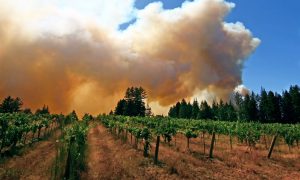
News release from the Lake County Winegrape Commission
With an increase in the number and duration of large wildfires, the California wine industry is working together to explore ways to combat the effect of smoke exposure and fire damage on winegrapes and wine. Industry leaders in Lake County, a region that has experienced multiple devastating wildfires in recent years, are leveraging data gathered from fires as a means to find solutions that will help wineries and grape growers minimize the impact from these natural disasters.
The Lake County Winegrape Commission (LCWC) is collaborating with the California Association of Winegrape Growers in CAWG’s effort to seek support from Congress by expanding the scope of an existing disaster assistance bill; additional collaborators include Lake County Farm Bureau, Mendocino Winegrowers Inc., and Mendocino County Farm Bureau. The request by CAWG and industry collaborators identifies the need for $5.25 million in funding to support intensive research to prevent and limit the effect of smoke on winegrapes during a wildfire. The research funding would support development of protective materials that can be applied in the vineyards and more accurate testing protocols for smoke compounds.
“We hope our collaborations are able to propel a more precise understanding of wildfire impacts on winegrapes,” said Debra Sommerfield, President of the LCWC. “It’s our intent to support innovative new findings that will not only further the understanding of impacts for winegrape growers in Lake County, but also set a precedent for the importance of future research across Northern California.”
To further understand the effects of smoke from wildland fires on grapes and wines, the LCWC initiated a collaborative research project in an effort to provide actionable insights. This research project comprises regional sampling, data gathering, weather- and fire-related GIS modeling, and sensory analysis. Project partners include UC Davis, UC Cooperative Extension, ETS Laboratories, the Australian Wine Research Institute, Western Weather Group, Lake County Air Quality Management District, and individual winegrape growers and vintners.


